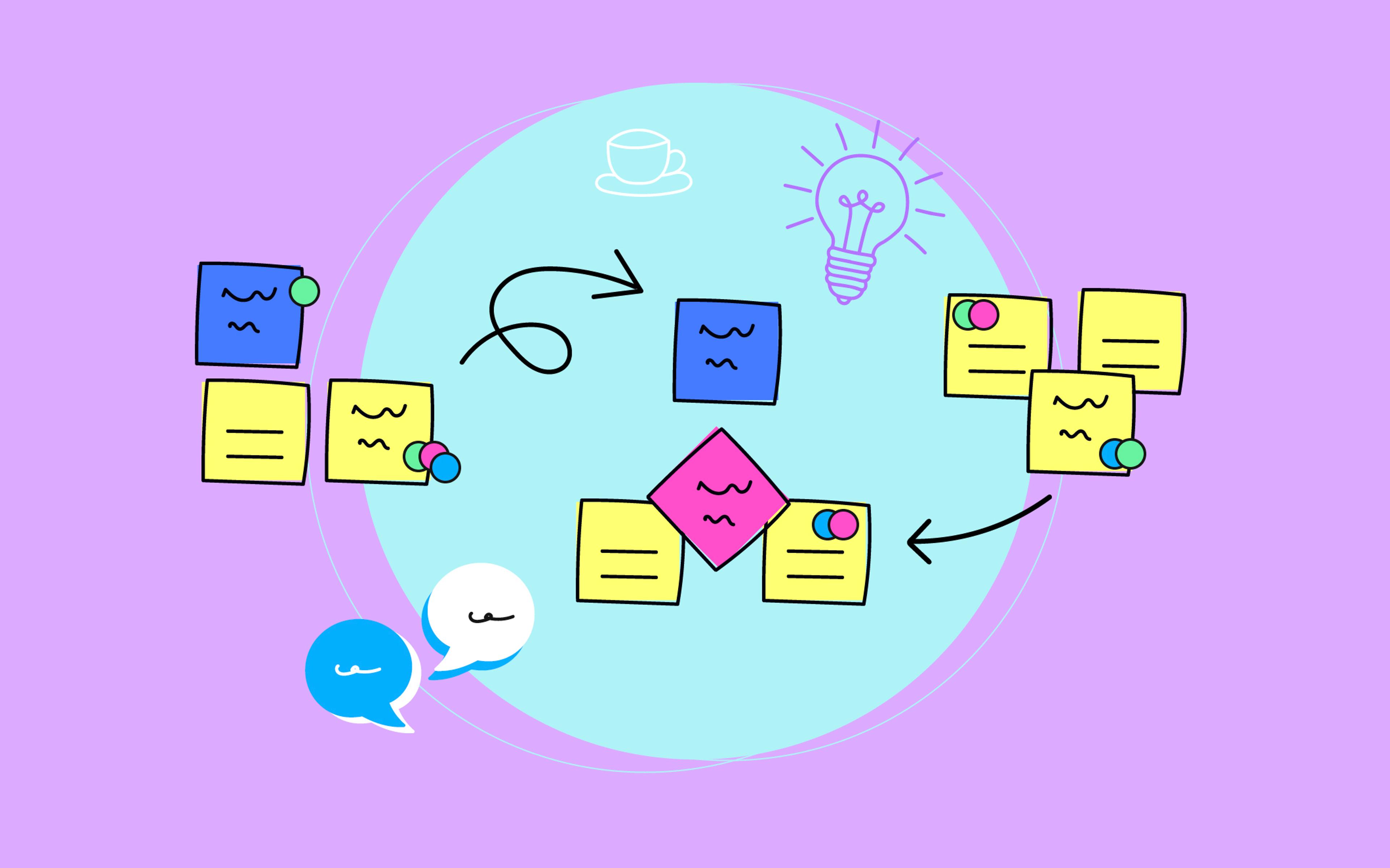Have you ever found yourself pondering over a complex problem for hours or days? You explore all possible paths yet end up with more doubts than certainty. Then, a casual conversation with a colleague suddenly illuminates your thoughts. Just articulating your challenge out loud, especially in a trusted circle, opens your mind and allows your ideas to blossom.
Imagine having a format to refer to every time you are stuck on a problem–a structured approach that unblocks the flow of ideas and brings order to chaos. A workshop is precisely that: a repeatable process to create an environment where conversation flows, ideas flourish, and solutions are nailed down.
At Nebulab, we use workshops to help our teams and clients navigate complex business domains, design efficient middleware integrations, and tackle multi-faceted productivity and collaboration challenges. Over the years, the humble workshop has proven, time and again, one of the most effective ways of taming complexity.
In this post, we’ll explore the practices we adopt for running workshops that bring value to both organizers and attendees.
The Key Ingredients of a Good Workshop
If you’ve watched movies like A Beautiful Mind or the recently released Oppenheimer, you might be familiar with the process mathematicians use to dig into a problem. They gather in front of a whiteboard, and for the most part, they sketch formulas and diagrams rather than relying on verbal communication. They alternate themselves in the writing, pause, take a step back to glimpse what they produced, and question their thoughts with “what if” questions.
It might not be evident at first glance, but these whiteboard conversations have a lot in common with workshops:
- The participants are exploring a complex domain
- The rules of engagement are well-understood
- The physical environment has the proper setup
- The participants visualize their concepts
All these elements are integral to a successful workshop, all concurring to create a space where ideas can be developed and examined collaboratively.
Let’s take a look at each of them, one at a time.
Complexity and Collective Intelligence
The heart of a workshop lies in the rich interaction between participants.
This interactive environment is particularly effective when tackling complex problems characterized by uncertainty or requiring diverse expertise. Participants from different areas of the business (e.g., industry experts, e-commerce managers, and tech leaders) bring a range of diverse insights that rarely have a chance to converge.
In a workshop, we leverage the group's collective intelligence, which often leads to superior decision-making, problem-solving, and innovation than an individual could achieve by themselves. This is particularly true in scenarios where the complexity of the subject matter benefits from a multitude of perspectives.
Each aspect of a workshop–from its physical setup to the methods of visualization and facilitation– is designed to harness this collective wisdom to navigate and illuminate complex issues.
Rules of Engagement
A simple, clearly understood set of rules is essential to facilitate efficient interaction and meaningful conversation in a workshop.
We can’t just put people in a room and expect valuable outcomes to emerge. Every workshop has a format and rules; for mathematicians, the format is mathematical symbolism, and the rule is to alternate in front of the whiteboard until a satisfactory outcome is achieved.
It’s critical to keep things simple: the participants need to be focused on exploring the problem domain, not on remembering or feeling constrained by the rules.
For instance, in a workshop I recently facilitated, we started with two rules: blue sticky notes to indicate a system and yellow sticky notes for activity in a system or data exchanged by two systems. In the second half of the workshop, I introduced a third rule: red sticky notes to highlight the critical/challenging aspects of a system’s behavior. With such a simple set of rules, all participants had an easy time contributing, the workshop ran all day with little effort, and the outcomes were excellent.
Pro tip: progressively revealing the rules is a trick that helps attendees focus on the matter at hand and ensures they aren’t overwhelmed.
Physical Environment
An often overlooked but crucial aspect of workshops is the room setup.
Adequate space is necessary for participants to move freely, interact with each other, and engage with tools like boards or flipcharts. Think of the mathematician with unobstructed access to their whiteboard–this accessibility is critical.
In my experience, it's beneficial to rearrange the furniture to suit the workshop's needs. Typically, I align chairs along the room's perimeter, creating a central, open area in front of the board or designated workspace. This layout encourages movement, collaboration, and a focus on the current task.
Remember: the ideal setup can vary depending on the nature and size of the workshop. The goal is to create an environment that fosters active participation and easy access to your collaboration tools.
The Power of Visualization
Relying exclusively on verbal communication often limits us to our existing mental models, creating a clash where new, breakthrough ideas struggle to emerge. This is because it's easier to interpret what we hear within our existing frameworks than to challenge and change them.
Visualization offers a powerful solution to this limitation.
Going back to our example, mathematical symbols serve as the visualization tool. For a diverse workshop audience, simpler tools are often more effective: these can be post-its, diagrams, or even Lego bricks. Visualizing concepts on a wall is particularly impactful: it not only allows workshop participants to step back and see the 'big picture,' but also ensures that all participants can engage and contribute equally.
This method ties in with our earlier discussion on room setup (an open space in front of a wall facilitates this kind of visualization) and with the idea of a simple ruleset (guiding participants on how to contribute visually is vital).
The Role of the Facilitator
In our example, a group of mathematicians might naturally fall into a collaborative rhythm without a facilitator. However, in a larger group setting, especially with individuals who have strong perspectives and diverse backgrounds, having a facilitator becomes essential.
A facilitator isn’t required to be a domain expert. Instead, their skills lie in observing group dynamics, actively engaging participants, offering suggestions discreetly, and summarizing discussions. The facilitator must be able to identify and guide the group’s focus to emerging concepts, even when they don’t have an in-depth understanding of the workshop’s subject.
Facilitators are crucial in navigating the complexities of group interactions, which can be unpredictable and challenging.
A note of caution to facilitators: not every workshop goes as planned, hence flexibility is key. Much like a jazz musician improvising in a jam session, a facilitator must read the room and adjust the workshop's flow as needed.
A good facilitator can transform a potentially chaotic discussion into a harmonious and productive session.
How We Use Workshops at Nebulab
Across various industries, workshops are versatile tools that can be tailored to various needs. From Retrospectives and User Story Mapping in Agile teams to Event Storming for Domain-Driven Design architectures, their applications are manifold.
As an e-commerce agency, we find workshops particularly effective in two main areas. Hopefully, you can use these examples as inspiration for your own workshops.
E-Commerce Middleware Design
Firstly, as detailed in my previous blog post, we use workshops to explore connections and dependencies between systems when architecting middleware software.
This workshop format is inspired by Event Storming, and it’s best described as a form of generative business process mapping: treating the wall as a timeline, we use sticky notes to represent the systems we are discussing (e.g., the e-commerce platform or the ERP software), the activities performed by the user or system, and events those activities generate.
Aligning the sticky notes on a timeline gives us a general overview of the business process and the system’s relationships. It also allows us to rearrange the responsibilities and dependencies between systems and the middleware.
On the brand side, we typically invite any stakeholders with an active role in the systems we’re analyzing. On the Nebulab side, we have a workshop facilitator, one or more strategists to provide insights into the business domain, and technologists to provide insights into the system’s architecture.
E-Commerce Domain Mapping
Workshops are also invaluable when implementing complex business rules or requirements deeply rooted in a brand's unique domain.
In this case, we start by representing the different types of actors involved in the domain, then the names of the business rules, and then the logic behind each rule. Finally, we arrange everything as a tree. Focusing on the users and visually representing the conditions and constraints applied to the system helps us untangle complex business domains and spot corner cases that were not previously covered.
The value of these workshops lies in their ability to bring together people with diverse expertise–from those with deep business or process knowledge to technology experts who may not be as familiar with the brand's specific domain. This diversity is crucial for surfacing and clarifying assumptions, removing ambiguity, and fostering mutual understanding.
An additional benefit is the reorientation towards the “bigger picture.” It's common for individuals immersed in day-to-day tasks to lose sight of the organization’s broader objectives. These workshops serve as a vital tool to realign everyone’s focus on the overarching goals, ensuring a cohesive and comprehensive approach to problem-solving.
Don’t Be Afraid To Experiment!
If you are tackling a gnarly issue or trying to untangle a business problem, a workshop might be the answer you’re looking for. While they seem intimidating at first, the benefits of an effective workshop far outweigh the complexities–just follow the rules we’ve outlined, and you’ll be halfway through!
Of course, if you’re an e-commerce brand and would like some help from experienced facilitators who can challenge your assumptions and contribute with their own insights, feel free to reach out! We’re always down for a good workshop.



